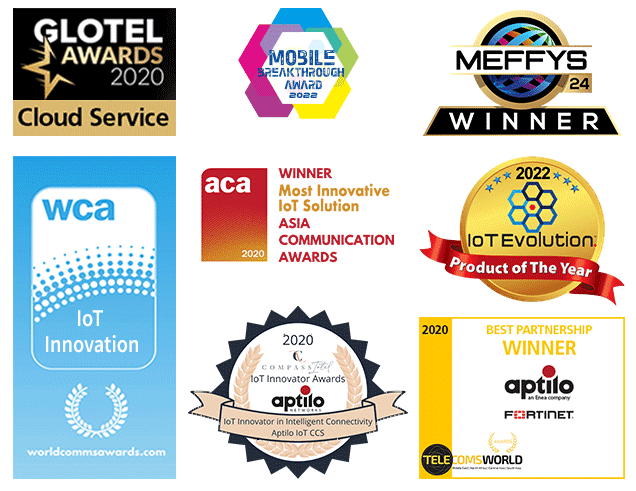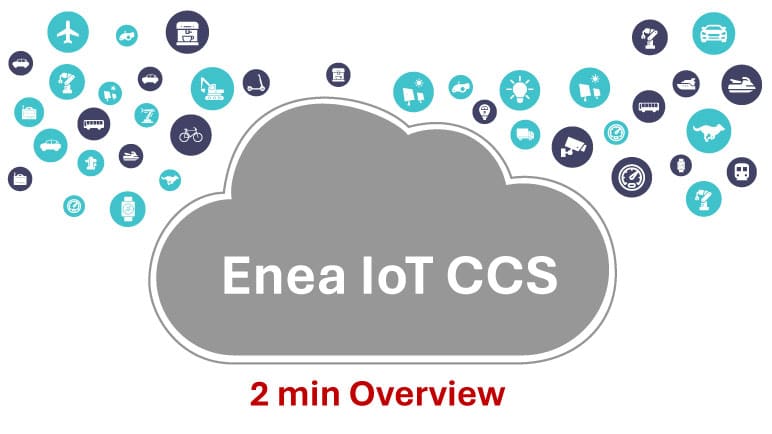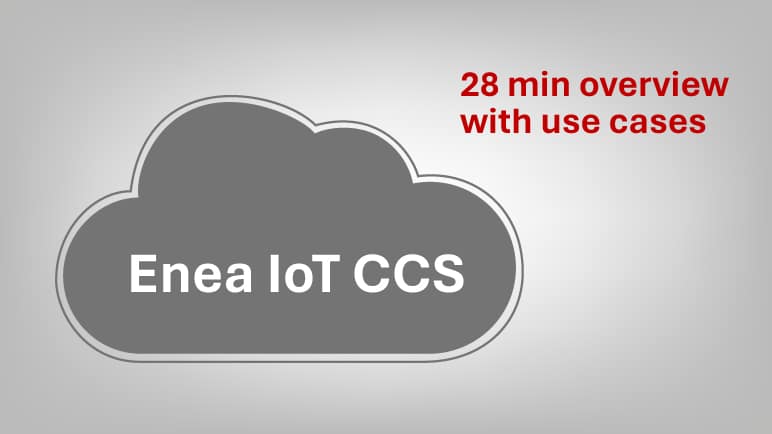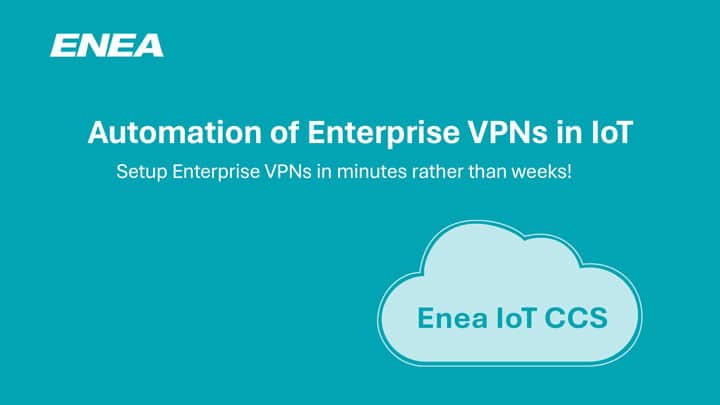Automate Enterprise VPNs on a Shared APN?
One shared APN is routed to IoT CCS and then separated to many enterprises.
Programmable Layer of Automation, Security & Policy
The Enea IoT Connectivity Control Service™ (IoT CCS) is an award-winning programmable layer for cellular IoT connectivity control, security, and automation delivered as a unique instance per IoT Connectivity Services Provider (IoT CSP) on Amazon AWS.
Enea IoT CCS introduces a new solution category on the market—the IoT Connectivity Control Function (ICCF)—and works in concert with existing Connectivity Management Platforms (CMPs).
IoT CCS is a unique market offering that effectively solves multiple long-standing challenges for IoT CSPs. Let’s explore some of these challenges and how IoT CCS solves them.
The answers to your challenges
One shared APN is routed to IoT CCS and then separated to many enterprises.
Avoid permanent roaming restrictions. Keep IP address and security policies for localized devices.
Provide a stateful firewall function with individual settings for each enterprise customer.
Answers to some of the most frequently asked questions about Enea IoT CCS.
Many IoT CSPs offer basic connectivity management, where customers can manage their SIM cards. The next step up often requires a wholly customized IoT connectivity service. Each customer deployment becomes a costly project with extensive manual configuration efforts. IoT CSPs are missing out on a mass market with customers prepared to pay for value-added services but not bespoke development.
We suggest IoT CSPs leave their core networks untouched and use hyperscalers to add a programmable, flexible layer of IoT connectivity control to their mobile infrastructure. Here, they can automate most of the customization efforts. Self-management portals allow customers to tailor connectivity policies and manage IoT security settings.
IoT CSPs do not have to spend resources creating this hyperscale IoT connectivity control layer!
Welcome to Enea IoT Connectivity Control Service™ (IoT CCS), an award-winning service hosted on Amazon Web Services (AWS). IoT CSPs can go beyond traditional IoT connectivity services by providing a programmable, automated, secure, flexible, and scalable global IoT connectivity. The IoT CSP sends the IoT traffic to their instance of IoT CCS through a secure IPSec tunnel(s). Global IoT connectivity is obtained by connecting international MNO partners and connectivity hubs to IoT CCS similarly.
The extensive IoT CCS API enables customer self-management with the automation of Enterprise VPNs.
The industry has acknowledged the benefits of Enea IoT CCS, our hyperscale IoT connectivity control solution. To date, we have been esteemed finalists for 12 awards and proudly selected as winner for 8 of them.
Discover below how an average enterprise can save a substantial 28 percent of their cost of global IoT connectivity by choosing an IoT CSP that has embraced a hyperscale approach.
“The key in this category was to bring real innovation in the market, and this is what Enea does. One jury member liked the fact that Enea IoT CCS addresses a real problem for mobile operators, enabling them to profitably launch IoT services while meeting the needs of enterprise customers, and another member said it had hyperscale potential.”
Presenting the Jury’s motivation at the 2021 WCA IoT Innovation Award

Hyperscale
Policy-based IP assignment is crucial to the most critical IoT CCS features, including our Multitenancy Private APN functionality and the ability to enable a genuinely unified IoT connectivity service.
Flexible IP assignment is also vital for you as an IoT CSP to meet enterprise customers’ needs. One would expect that the IP address would not matter much in modern IT architecture. Dynamically assigned IP addresses should be sufficient, and there would be mechanisms that update the IoT back-end when the IP address changes.
However, many enterprise IoT customers rely on keeping the same IP address for an IoT device and even their custom IP range for all their devices.
There are many benefits to letting a programmable hyperscale layer handle the IP allocation. The most obvious one is the ability to maintain the same IP address even when a device moves across your MNO partners’ networks.
With IoT CCS, the allocated device IP address and the IP address of the primary and secondary DNS server for the IoT device are provided in the RADIUS response to the packet gateway.
Note that with IoT CCS, mobile operators can assign the same IP address to a device also when it is localized by changing its SIM identity to belong to a partner MNO’s network. Learn more about the localization of eSIM/eUICC on our unified global connectivity page. This and consistent use of policies and security settings will provide a unified IoT experience across all partner networks.
Usually, an IoT CSP’s mobile core and OSS/BSS teams prioritize stability before being fast on their feet, implementing every change requested by demanding customers. With IoT CCS, IoT CSPs can free themselves from these limitations. It gives them the freedom to innovate IoT services that were impossible to achieve in a strict 3GPP environment. IoT CSPs can easily tailor IoT connectivity services to the specific needs of different customer types.
The IoT CSP’s self-management portals, enabled by IoT CCS’s extensive APIs, allow their customers to control IP assignment, authentication, security, policies, and global connectivity from a single user interface.
Through their customer self-management portals, IoT CSPs can automate the setup of VPNs and do not have to deal with the work of creating a unique APN for each customer. The first deployments have shown that IoT CSPs can dramatically reduce their manual Enterprise VPN setup process from many weeks to just a few minutes. Instead of the manual setup working with the IoT CSP’s engineers, customers can easily create as many Enterprise VPNs as they need using the self-management portal. Learn more about how Swisscom is leveraging the Multitenancy Private APN to chase the long-tail of IoT customers.
The FortiGate next-gen firewalls included in IoT CCS protect the IoT traffic.
You will get access to download all our IoT-related collaterals including White Papers and Solution Briefs. You may also want to visit our insights section.
If you have any questions, please do not hesitate to contact us!


Get an overview of IoT CCS in just 2 minutes.

This 28 min video will overview the groundbreaking IoT CCS service and show some example use cases for different market segments, including automotive, utilities, and the vast Small and Medium Enterprise (SME) market.

Get the complete picture of the award-winning Multitenancy Private APN functionality of Enea Aptilo IoT CCS in less than 5 min.
The concept of IoT connectivity management has changed. Providing a standard SIM card with roaming capabilities will not cut it anymore. IoT enterprise customers are much more diverse and demanding than you might imagine. Let us examine some example enterprise use cases that are very different in characteristics. These are anonymized cases from enterprise customers and customer discussions that our IoT CSP clients have had.
The use cases show how IoT CSPs can deliver the required functionality with a IoT Connectivity Control Function such as the Enea IoT CCS. The granular policy control delivered as a service makes it possible to create more advanced and innovative IoT services. The IoT CSP can also put the enterprise in the driver’s seat by implementing a self-service enabled by the IoT CCS API.
A modern car is a hub of multiple IoT devices. These devices come from subcontractors of suspension, batteries, brakes, security systems, entertainment systems, and more. They need private connectivity for firmware upgrades, sensitive data, and predictive maintenance.
Car-2-car communication requires low latency. Upload of extensive real-time analytics requires high upstream data capacity. The download of software or passenger entertainment needs high downstream data capacity. They may also need geographical routing rules determined by device profile settings. Furthermore, there may be a need to have localized Internet. The service must be able to route the Internet traffic to the home country’s Internet breakout to enable users to, e.g., watch their local streaming content while abroad.
There’s a need to secure the transport of sensitive data, such as analytics, software upgrades, and data for predictive maintenance. The best way to secure this data is to establish connectivity through Enterprise VPN tunnels. The service provider must support a one-to-many VPN connectivity controlled by the car manufacturer so they can include their sub-contractors in their own secure global SD-WAN.
Car manufacturers also have high-security requirements, end-to-end security, DDoS protection, anomaly detection, etc.
In the utilities market, a customer may need to connect hundreds of thousands, maybe millions, of “dumb” IoT devices such as electrical meters. They are dumb in the sense that they are simple and cheap, so they often lack security features such as VPN connectivity.
These devices have a vulnerable position in people’s homes. Thus, they need to be protected by firewalls. Some traffic may also need to be delivered through Enterprise VPN from the Enea IoT CCS.
A small local taxi and transport company is part of the small and medium-sized enterprise (SME) customer segment. The SME segment is the direct opposite of a car manufacturer because they have limited IT resources and only have a handful of devices.
They may run a few legacy systems that must have contact with the cars at all times. These systems have minimal security functions, as they were established before the Internet’s birth. So, they need operator-managed security. VPN tunnels are not an option for this customer because they can’t set up and manage VPN connections.
From the operator’s perspective, they need this type of customer to handle their settings. In this mass market, it is just not profitable if the customer needs too much assistance from the operator. There’s an enormous volume of potential customers in the SME segment, but each customer does not contribute much revenue. The SME market is a volume game. For self-management to work, an easy-to-use web GUI or app with basic settings is a must.
Companies offering app-based short-time rental of e-scooters are popping up like mushrooms in larger cities globally.
They have tens of thousands of relatively low-end devices in the form of e-scooters. This industry needs to secure the traffic from their e-scooters to the receiving servers.
The scooters are exposed to potential user manipulations, so they need to be protected by firewalls. Furthermore, e-scooter rental companies commission and decommission e-scooters regularly, and an average lifespan of a scooter is just a few months.
The forestry Industry needs complex domestic IoT connectivity. They need secure connectivity over a Private APN to their headquarters for services such as:
They may also want to enable Internet connection for the integrated tablet device available in many forestry machines. A firewall must protect this traffic, and they need to control this connection according to corporate policies.
Let’s explore how IoT CSPs can combine a connectivity control service such as IoT CCS with their ability to do dynamic eSIM localization. They can provision and upgrade settings in the eSIM, using their over-the-air (OTA) systems and the latest eUICC technology, and change the profile to the local operator on the fly.
This is excellent news for a transport company operating all over North- and Central America. They can turn to one mobile operator in Canada to solve all their connectivity needs both domestically and abroad under one contract.
By connecting all partner MNOs to the Enea IoT CCS, the mobile operator can offer a unified global APN+VPN connectivity without roaming. The truck will, for instance, maintain its IP address, security, and policies across borders.
Let’s see what happens as the truck passes different countries. We start in Canada. When the vehicle enters the United States, this enables the profile for the US partner MNO over the air. The truck continues to Mexico, and the OTA system ensures that the eSIM switches to the local MNO partner in Mexico.
If needed, the Enea IoT CCS service can offer policy-based breakout for all or parts of the traffic to the nearest AWS point-of-presence.
The need for global connectivity can also just be a matter of logistics. Take a manufacturer of coffee machines rented out to coffee shops worldwide.
Just imagine the benefits of less tied-up capital in stock by storing only one version of the machine instead of individual versions for each country. Doing this under one operator contract and still applying the same security and policies through Enea IoT CCS while allowing some traffic to break out in the local region and some routed home in secure Enterprise VPNs.
Just as in the case of international transportation, the mobile IoT CSP must go beyond roaming and instead localize eSIMs over-the-air (OTA) to local subscriptions. This will eliminate the issue of blocking IoT devices due to breaches of regulations and commercial agreements prohibiting permanent roaming. To maintain control, IoT CSPs can use the unified global connectivity functionality built into Enea IoT CCS.
Cellular IoT Connectivity Service Providers (IoT CSPs) and their enterprise customers will hugely benefit from a Hyperscale IoT connectivity management solution such as the Enea Aptilo IoT CCS. As you will find under the Enterprise benefits tab an average enterprise will save the equivalent of 27.8 percent of the cost of their global IoT connectivity.
Let’s start with stating the obvious. Using hyperscalers such as Amazon AWS makes an IoT connectivity management solution inherently scalable and global.
Now we will dig into how Enea IoT CCS helps IoT CSPs scale their value-added IoT services with profit.
The matrix above shows two perspectives IoT CSPs need to consider when creating IoT connectivity management services. On the X-axis, we have the business value the IoT connectivity service brings to the enterprise IoT customer. On the Y-axis, you find the profit the IoT connectivity service brings to the operator.
IoT CSPs will end up in the bottom left corner If they just re-package an existing consumer service for IoT.
Most operators also add SIM-management and offer private connections on top of this. The keyword here is ‘most.’ They will deliver a commodity with little value-add. They will only compete on price, and the lowest bidder will replace them. These mobile operators are in the “churn zone” colored red in the matrix.
In the left half of the matrix, operators will only be able to create a profitable IoT business if they become the price and volume leader in their market.
The further you move towards the right, adding value-added services, the stickier customers become. Higher revenues come with value-added services such as Analytics, Managed Security, Global Connectivity, and Granular policies.
But, for most operators, the profit will not follow. Every new customer that needs value-added services becomes an expensive development project.
There’s only one way to scale value-added IoT services with high profit: to automate the customization as much as possible. Mobile operators should also add a web interface for customer self-management. Automation and self-management serve two purposes. First, they will get a lower cost of operation. Second, customers will be less price-sensitive, as the service feels like their own when integrated with their business processes.
So, the green zone, which we call the high-profit zone, is where you want to be as an IoT CSP. The question is if even a dedicated mobile core for IoT and your current organizational processes will take you there? One of Enea’s mobile operator customers answered no to that question. And so, the award-winning Enea IoT CCS was born.
As discussed initially, most IoT CSPs offer basic IoT connectivity management. The next step up is a customized IoT connectivity service. With each customer deployment carried out as a costly project, operators are missing out on a mass market with customers prepared to pay for value-added services but not for bespoke development.
What’s more, many bespoke deployments are very similar, which shows the potential to deliver those projects more cost-effectively.
This is where Enea IoT CCS comes in.
We believe there is enormous potential in stopping making customizations as soon as a customer wants something beyond a standard service.
With a IoT Connectivity Control Function (ICCF), such as IoT CCS, it is easy to be agile and create new value-added services that fit multiple customers. As a result, it will be possible to move the bulk of customization projects to a scalable IoT service instantly deployed to any customer. This is an auto-customization approach where the customer can make the last few customization steps themselves and maintain the service through self-management.
Just the automation of Enterprise VPNs and only having to handle one APN to serve all customers is reasons enough to go with a IoT connectivity management solution. Such a solution will free up resources to do bespoke developments for the very few who need it. But IoT CCS is also relevant for custom development. The logic and security part of a bespoke project can also benefit from being handled in the cloud. It is faster to deploy new server or firewall nodes, and operations can isolate and tailor specific nodes for the customer if needed.
There are four significant benefits of a hyperscale IoT connectivity control function from the enterprise customers’ point of view:
Using only one common APN, as we do in our Multitenancy Private APN concept, is also beneficial for enterprise customers. If the customer needs to change the APN, the IoT device logic may need updating. Updating thousands of devices is not a straightforward operation, especially if they are in remote locations. The IoT CCS service reduces the need for these critical updates because the one shared APN can point to multiple VPN connections, there is no need to change any APN names in the devices.
Analyst firm Transforma Insights estimates that customers using a hyperscale IoT connectivity service can save the equivalent of 27.8 percent of the cost of global IoT connectivity.
That equates to an astonishing 117 billion USD globally between 2020 and 2030.
Source: Transforma Insights’ White Paper
As you can see the domain of Enea IoT CCS, architecture and integration, stands for the vast majority of the cost-savings.
The largest cost-saving is in Device-to-Cloud Integration (7.5%), closely followed by faster Time-to-Market (6.4%) and lower costs of providing the equivalent levels of security (5.3%).
Enterprises can also save a lot (5.9%) by using eSIM/eUICC and localizing the connectivity onto a domestic network, avoiding regulatory or commercial compliance issues.
Enterprise IoT customers’ needs are diverse and demanding. It is not just a matter of adding IoT SIM-management capabilities to an existing mobile core.
Mobile operators must deliver a programmable and secure global IoT connectivity management solution that they can deploy instantly. To achieve this, they need to think outside the limitations of their current mobile core and organizational processes.
Mobile operators must add a hyperscale programmable layer for cellular IoT connectivity control. This is what Enea IoT Connectivity Control Service™ (IoT CCS) offers as an OPEX-based pay-as-you-grow service, hosted on AWS.
Let Enea’s experts guide you in the evolution of telecom and network communication. We regularly create and publish new content in channels customized to your interests.
Enea’s experts are regularly publishing new articles, blog posts, white papers, webinars, and more. Use the filters!
Subscribe to receive the latest insights directly into your inbox – you choose the topics.
Follow our dedicated channel for telecom operators, where Enea’s experts regularly publish news and insights.